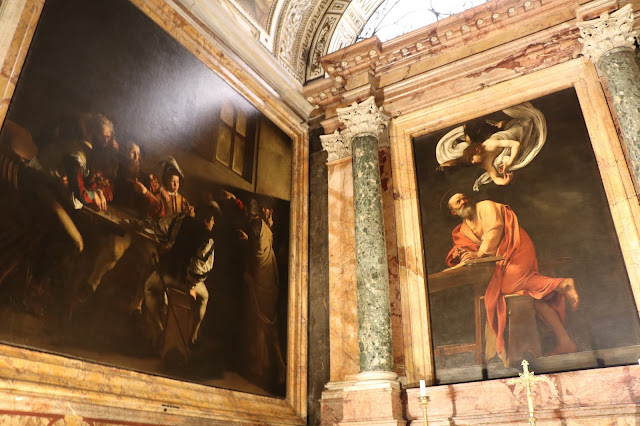When we arrived on the Friday afternoon, we passed through the Piazza Navona which is famous for its fountains. At that time it was absolutely full of tourists. So we got up early on Sunday morning and headed back to the Piazza and had it almost entirely to ourselves.
h
Here's us at the famous Fontana dei Quattro Fiumi or Fountain of the Four Rivers 1651, by Bernini.
Then we were off to the Piazza Valentini, where underneath they discovered a wealthy Roman Patrician’s home called the Domus Romane. In the underground area opposite Trajan's Column are the remains of bricked rooms with vaulted ceilings, dating from the early years of the emperor Hadrian, according to stamps on the bricks. The remains of the patrician "Domus" of imperial Rome, belonging to powerful families, with mosaics, wall decorations, polychrome floors, paving blocks, and other remains. It had been buried and forgotten and rediscovered in the nineteenth century and they’ve done more excavations recently. When it was lived in, overlooked Trajan’s Column. The Domus Romane had glass covered walkways so you could look down into the old excavated house and the museum had a projector that displayed what the house probably looked like during it’s heyday onto the walls. It was really cool. They also found evidence underneath of a nearby temple that had granite pillars larger than the ones at the Pantheon. They think the temple must have been massive.
They also explained what Trajan’s column was about. Firstly, it was built to show where the hill had been before it was excavated to make the space for Trajan's Forum and secondly the images were to commemorate Trajan’s victory over the Dacians (modern day Romania). It is 40 metres high and carved into the structure 2,662 figures in 155 scenes. If you look closely here you can see Trajan watches a battle, while two Roman auxiliaries present him with severed enemy heads. Also, one of the Roman soldiers is holding the head of his enemy by the hair from his mouth (close up of that underneath).
Then onto the wedding cake. The Vittorio Emanuele Monument was completed in 1925 to commemorate the unification of Italy. Seems Italians think it’s a little over blown and they call it things such as the Wedding Cake and the Typewriter. We found it surprisingly cool.
What to have for lunch? Had heard about this excellent new dining experience in Rome called Retrobottega.
The recommendation was sit at the bar and watch the chefs, which we did. Food did not disappoint.
Found a church, San Luigi dei Francesi, that had three Caravaggios in it (Rome is simply crawling with them). The Martyrdom of St. Matthew , St. Matthew and the Angel and Vocation of St. Matthew.
Booked a lovely restaurant called Marzapane for our Sunday night dinner. Had the tasting menu with matching wines. Yum!


















